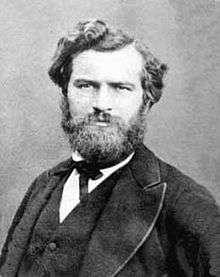Camille Jordan
| Camille Jordan | |
|---|---|
 | |
| Born |
5 January 1838 Lyon |
| Died |
22 January 1922 (aged 84) Paris |
| Nationality | French |
| Fields | Mathematics |
| Alma mater | École polytechnique |
| Academic advisors | Victor Puiseux and Joseph Alfred Serret |
| Known for |
Jordan curve theorem Jordan normal form Jordan matrix Jordan measure |
Marie Ennemond Camille Jordan (French: [ʒɔʀdan]; 5 January 1838 – 22 January 1922) was a French mathematician, known both for his foundational work in group theory and for his influential Cours d'analyse.
Biography
Jordan was born in Lyon and educated at the École polytechnique. He was an engineer by profession; later in life he taught at the École polytechnique and the Collège de France, where he had a reputation for eccentric choices of notation.
He is remembered now by name in a number of foundational results:
- The Jordan curve theorem, a topological result required in complex analysis
- The Jordan normal form and the Jordan matrix in linear algebra
- In mathematical analysis, Jordan measure (or Jordan content) is an area measure that predates measure theory
- In group theory the Jordan–Hölder theorem on composition series is a basic result.
- Jordan's theorem on finite linear groups
Jordan's work did much to bring Galois theory into the mainstream. He also investigated the Mathieu groups, the first examples of sporadic groups. His Traité des substitutions, on permutation groups, was published in 1870; this treatise won for Jordan the 1870 prix Poncelet.[1]
The asteroid 25593 Camillejordan and Institut Camille Jordan are named in his honour.
Camille Jordan is not to be confused with the geodesist Wilhelm Jordan (Gauss–Jordan elimination) or the physicist Pascual Jordan (Jordan algebras).
Bibliography
- Cours d'analyse de l'Ecole Polytechnique ; 1 Calcul différentiel (Gauthier-Villars, 1909)
- Cours d'analyse de l'Ecole Polytechnique ; 2 Calcul intégral (Gauthier-Villars, 1909)
- Cours d'analyse de l'Ecole Polytechnique ; 3 équations différentielles (Gauthier-Villars, 1909)
- Mémoire sur le nombre des valeurs des fonctions (1861–1869)
- Recherches sur les polyèdres (Gauthier-Villars, 1866)
- Jordan, Camille (1870), Traité des substitutions et des équations algébriques, Paris: Gauthier-Villars
- The collected works of Camille Jordan were published 1961–1964 in four volumes at Gauthier-Villars, Paris.
See also
- Jordan–Chevalley decomposition
- Jordan totient function
- Jordan–Schur theorem
- Jordan–Schönflies theorem
- Jordan's lemma
References
- ↑ "Prix". Comptes rendus hebdomadaires des séances de l'Académie des sciences. Tome 75, Juillet à Décembre 1872. Paris: Gauthier-Villars. 1872. p. 1302.
External links
- O'Connor, John J.; Robertson, Edmund F., "Camille Jordan", MacTutor History of Mathematics archive, University of St Andrews.